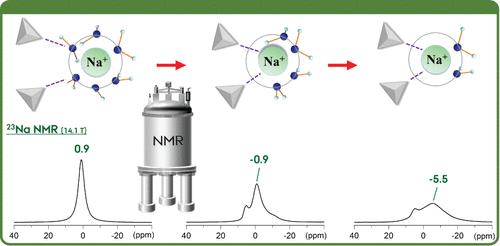当前位置:
X-MOL 学术
›
J. Phys. Chem. C
›
论文详情
Our official English website, www.x-mol.net, welcomes your feedback! (Note: you will need to create a separate account there.)
Sodium Sites and Hydration State in C–S–H Phases Synthesized under Alkaline Conditions from 1H and 23Na NMR Experiments
The Journal of Physical Chemistry C ( IF 3.3 ) Pub Date : 2024-06-18 , DOI: 10.1021/acs.jpcc.4c01982 Sheng-Yu Yang 1 , Jo̷rgen Skibsted 1
The Journal of Physical Chemistry C ( IF 3.3 ) Pub Date : 2024-06-18 , DOI: 10.1021/acs.jpcc.4c01982 Sheng-Yu Yang 1 , Jo̷rgen Skibsted 1
Affiliation

|
Alkali ions play a crucial role in cement hydration as they are the first species to dissolve, resulting in a pH increase, which promotes the hydration reactions. The location of the alkalis after hydration is less understood; however, it is known that significant amounts are associated with the principal binding component, the calcium-silicate-hydrate (C–S–H) phase. The present work investigates the potential of 23Na NMR to study adsorption, incorporation, and hydration states of sodium in pure C–S–H phases with Ca/Si ratios of 0.8 and 1.4, synthesized from Ca(OH)2 and silica in 0.5 M NaOH solutions. The 23Na NMR spectra (14.1 T) of the synthesized samples are dominated by a featureless resonance from sodium coordinated to water in [Na(H2O)6]+ complex ions. Dehydration of the samples in an oven, by long-term MAS spinning, or by storage at different humidities results in a systematic shift of the main resonance toward lower frequency, reflecting sequential removal of H2O from the sodium hydration shell. Lineshape analyses reveal that the low-frequency shifts result from increasing quadrupole couplings for constant isotropic chemical shifts. Rehydration of the samples shows that water can be incorporated into the hydration shell again. 23Na MAS and MQMAS NMR spectra at different magnetic fields (14.1 and 22.3 T) allow identification of three distinct sodium environments in the C–S–H samples, for which 23Na isotropic chemical shifts and quadrupolar product parameters have been determined with good accuracy. The three resonances are assigned to a surface Na site and two interlayer Na sites in the C–S–H structure.
中文翻译:

1H 和 23Na NMR 实验在碱性条件下合成的 C-S-H 相中的钠位点和水合状态
碱离子在水泥水化中起着至关重要的作用,因为它们是最先溶解的物质,导致 pH 值升高,从而促进水化反应。水合后碱的位置知之甚少。然而,众所周知,大量与主要结合成分、硅酸钙水合物 (C-S-H) 相相关。目前的工作研究了 23 Na NMR 在研究 Ca(OH) 合成的 Ca/Si 比为 0.8 和 1.4 的纯 C-S-H 相中钠的吸附、掺入和水合状态的潜力。 ) 2 和二氧化硅在 0.5 M NaOH 溶液中。合成样品的 23 Na NMR 谱 (14.1 T) 主要是[Na(H 2 O) 6 ] + 络离子。通过长期 MAS 旋转或在不同湿度下储存,在烘箱中对样品进行脱水,导致主共振系统地向较低频率移动,反映了从钠中顺序去除 H 2 O水合壳。线形分析表明,低频位移是由于恒定各向同性化学位移增加四极耦合所致。样品的再水化表明水可以再次并入水化壳中。 23 不同磁场(14.1 和 22.3 T)下的 Na MAS 和 MQMAS NMR 谱可以识别 C-S-H 样品中三种不同的钠环境,其中 23 Na 各向同性化学位移和四极产物参数的测定具有良好的准确性。三个共振分配给 C-S-H 结构中的一个表面 Na 位点和两个层间 Na 位点。
更新日期:2024-06-19
中文翻译:

1H 和 23Na NMR 实验在碱性条件下合成的 C-S-H 相中的钠位点和水合状态
碱离子在水泥水化中起着至关重要的作用,因为它们是最先溶解的物质,导致 pH 值升高,从而促进水化反应。水合后碱的位置知之甚少。然而,众所周知,大量与主要结合成分、硅酸钙水合物 (C-S-H) 相相关。目前的工作研究了 23 Na NMR 在研究 Ca(OH) 合成的 Ca/Si 比为 0.8 和 1.4 的纯 C-S-H 相中钠的吸附、掺入和水合状态的潜力。 ) 2 和二氧化硅在 0.5 M NaOH 溶液中。合成样品的 23 Na NMR 谱 (14.1 T) 主要是[Na(H 2 O) 6 ] + 络离子。通过长期 MAS 旋转或在不同湿度下储存,在烘箱中对样品进行脱水,导致主共振系统地向较低频率移动,反映了从钠中顺序去除 H 2 O水合壳。线形分析表明,低频位移是由于恒定各向同性化学位移增加四极耦合所致。样品的再水化表明水可以再次并入水化壳中。 23 不同磁场(14.1 和 22.3 T)下的 Na MAS 和 MQMAS NMR 谱可以识别 C-S-H 样品中三种不同的钠环境,其中 23 Na 各向同性化学位移和四极产物参数的测定具有良好的准确性。三个共振分配给 C-S-H 结构中的一个表面 Na 位点和两个层间 Na 位点。






































 京公网安备 11010802027423号
京公网安备 11010802027423号